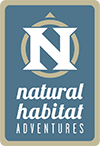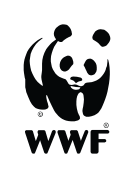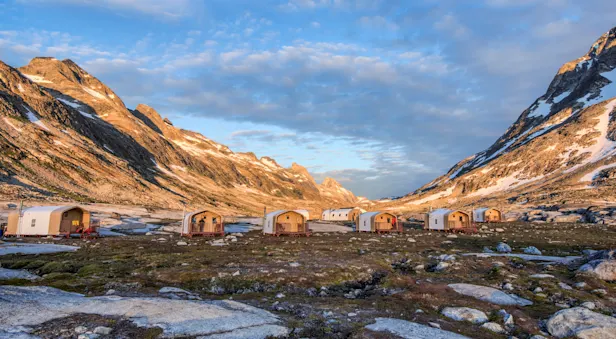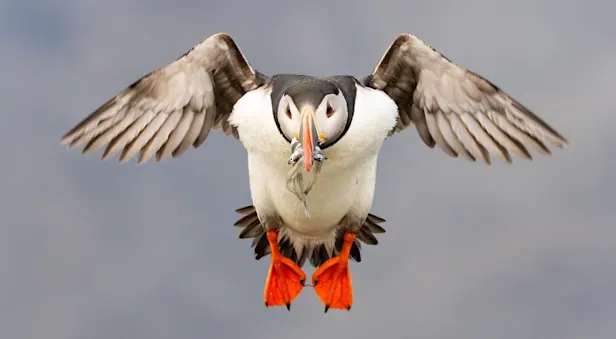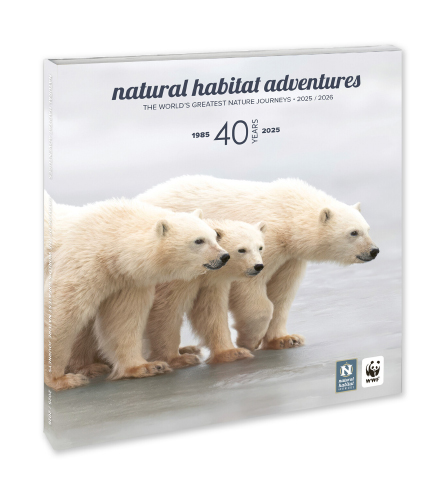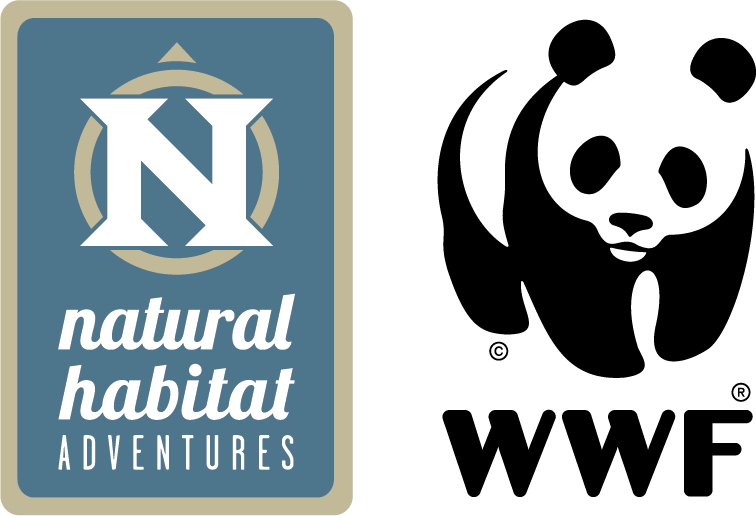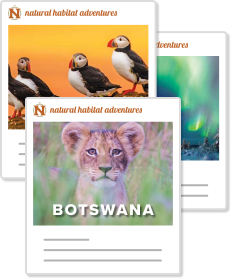Classic Itinerary
Arrive at Keflavik International Airport where you are met on arrival and transferred to our hotel in Reykjavik, about a 45-minute drive. This evening, join our Expedition Leader for a welcome dinner at a local restaurant, with an orientation to all the adventures that lie ahead in this geological wonderland.
Day 2: South Shore—Lava Center / Waterfalls / Vik—Lava Show

Explore Iceland's south coast en route to Vik, an area known for its volcanic black sand beaches and countless waterfalls. We are in the region affected by the powerful 2010 eruption of Eyjafjallajokull volcano, an event brought to life at the Lava Center, which features interactive exhibits depicting the colossal natural forces that have created Iceland over tens of millions of years. Our knowledge of Iceland's dynamic geology is enhanced as we learn about the eruptions and lava flows, rift systems, faults and glacial floods that make the island a showcase of volcanism. The center introduces us to the UNESCO Katla Global Geopark plus Iceland's elaborate monitoring system for surveying volcanos and earthquake zones.
Continuing along the south coast, we stop at several thundering waterfalls, including powerful Skogafoss and Kvernufoss. Another famous highlight is Reynisdrangar Rocks, a trio of columnar basalt sea stacks. Legend holds that they were formed after two trolls were out fishing in a three-masted ship. When the trolls did not return to their cave before sunrise, they and their vessel turned into needles of stone, since trolls cannot tolerate daylight. Here, we'll have a chance to walk on the famous black sand beach before continuing to the exciting Lava Show in Vik, followed by dinner at the restaurant on site. The Lava Show, renowned for its educational value, recreates a volcanic eruption by superheating real lava up to 2000°F, then pouring the molten rock it into a room at close range where guests can watch it flow, hear it sizzle and feel the incredible heat. After dinner, continue to our nearby hotel to spend the night.
Day 3: Skaftafell—Private Glacier Walk or Park Hike / Private Zodiac Tour of Fjallsarlon Glacier Lagoon
Our focus today is Skaftafell, a national park now absorbed inside the larger Vatnajokull National Park established in 2008. Known for its rugged landscapes, mountains and glaciers, Skaftafell contains about half of the Vatnajokull Glacier, Europe’s largest ice cap. No roads penetrate the park’s wild recesses, but two options offer a chance to explore a slice of it: Choose between a walk atop a glacier or an easy hike with glacial views. We then board a private Zodiac to explore Fjallsarlon Glacier Lagoon, a less-touristed opportunity to get close to floating icebergs. The lake is the meltwater from Fjallsarlon Glacier, a tongue of the massive Vatnajokull Glacier, which has calved the huge chunks of blue ice that drift on the surface.
Day 4: Djupivogur Private Walking Tour / Vallanes Farm / Modrudalur
Enjoy a day of cultural connections as we enter the East Fjords, a little-visited region of forests, farms and picturesque fishing villages. In the town of Djupivogur, take a scenic walk along the coast near Alftafjordur, then join a local resident for a stroll around a historic fishing town, learning about daily life where traditions and livelihoods center on the sea. After, admire the Eggs of Merry Bay, one of Iceland’s most unusual sculptures. Created in 2009 by Icelandic artist Sigurdur Gudmundsson, the 34 large-scale egg replicas represent 34 bird species found in the area, each one mounted on a platform along the harbor.
Heading inland, follow a remote road to Vallanes Farm where we stop for hot drinks and snacks at this organic farm and cafe crafted of sustainably harvested wood. Continue to Modrudalur, one of the oldest farms in Iceland, with evidence of its presence since the original settlement by the Vikings. The site was an important crossroads where two historic cross-country trails intersected, and its location is referenced in the famous Sagas that date to the 10th and 11th centuries. Modrudalur is also the highest inhabited place in Iceland, at 1,539 feet above sea level. We spend the next two nights here at Fjalladyrd, a hospitable family-run farm and guesthouse that offers easy access to Askja volcano for our 4x4 adventure tomorrow.
Day 5: Askja Caldera Private Super Jeep Tour / Modrudalur
Set out in Super Jeeps this morning for a thrilling tour to Askja caldera. These large SUVs have been modified with big tires and extra shock absorption to provide a more comfortable ride over off-road terrain, allowing deeper access into Iceland’s central highlands. We ascend on foot to explore the massive Askja caldera, formed when successive volcanic eruptions repeatedly emptied the magma chamber, causing the ground to drop. Lake Askja, formed when the volcano erupted in 1875, fills part of the depression and is one of the deepest lakes in Iceland, at nearly 700 feet. The caldera contains several overlapping craters with active volcanoes beneath, including Viti, which warms a sulphuric blue-green crater lake. Following a picnic lunch, explore more of Iceland's little-visited Central Highlands before returning to Modrudalur for a second night at Fjalladyrd.
Please note: On early and late season departures when snow may affect our access to Askja Caldera, or when visibility is significantly limited by inclement weather, we will substitute with an alternative Super Jeep tour in the Highlands. Our journey may include a secret waterfall and 5,501-foot Herdubrid, a peak known as the “Queen of Iceland.” A highlight is Hafrahvammagljufur Canyon, a dramatic gorge more than 650 feet deep.
Day 6: Dettifoss / Hverarond / Lake Myvatn—Optional Horseback Ride / Hot Springs
Witness the power of Dettifoss, Europe’s largest waterfall by volume and the most powerful cataract in Iceland. This thundering curtain of water, 330 feet wide and 150 high, is fed by the giant Vatnajokull Glacier. If we're lucky, we might see a rainbow over the falls, which makes for dramatic photos. Next we explore the Hverarond geothermal area, an otherworldly setting of hissing steam vents, bubbling mud pots, cracked earth and pungent sulphur, then continue to Lake Myvatn. Formed during a massive eruption 2,300 years ago, the Myvatn region is still a site of geothermal activity, with lava flows coming most recently from the 1984 eruption of Krafla volcano. Numerous lava formations are found in and around the shallow lake, and we explore the pseudocraters of Skutustadir on a short hike, observing local birdlife. These phenomena are formed when lava flows over wet ground, pushing it down and trapping steam. As pressure mounts, steam explosions create these fascinating "false craters." One of the premier birdwatching areas in the world, Lake Myvatn’s marshes provide habitat for huge numbers of migratory birds in summer. More than 115 species have been seen at the lake, including 13 species of nesting ducks, and we hope to see some of them on our walk.
This afternoon, explore the fascinating lava formations around Lake Myvatn on horseback. This optional 1-hour private ride offers a striking vantage point on the region's wondrous geological features, including whimsically shaped pillars and a close-up look at a false crater. For those who may not wish to ride, a birdwatching walk is an alternative. Later today, enjoy a quintessentially Icelandic experience with a soak in a nearby thermal bath. At Myvatn Nature Baths, amid clouds of steam rising from a fissure deep in the Earth, immerse yourself in soothing, milky-turquoise water that's naturally heated by geothermal forces. Drawn from depths of up to a mile and a half below the surface, temperatures in the lagoon pools range from 98°F to 103°F.
Day 7: Dimmuborgir / Godafoss / Chartered Flight to Isafjordur
The day begins with a stop at Dimmuborgir, a dramatic lava field formed by a volcanic eruption some 2,300 years ago and distinguished by towering rock pillars, caves and unusual lava formations. Continuing westward, we stop at Godafoss, one of Iceland’s most beautiful waterfalls originating deep in the highlands. Shaped like a crescent, it drops 40 feet over a sheer volcanic cliff. Reaching Akureyri, connect with our late-afternoon chartered flight to Isafjordur, with scenic views of Iceland's indented coastline and glacier-carved interior en route. Originally settled in the 9th century, Isafjordur became a trading post for foreign merchants in the 16th century and today is the main town in the remote Westfjords in far-northwest Iceland.
Day 8: Exploring the Westfjords—Private Super Jeep 4x4 Excursion
The sheer isolation of the Westfjords region has kept it off the traditional tourist circuit, and we traverse it in depth over the next three days, adjusting our exact itinerary for weather and local conditions. We explore the wild hinterlands on an all-day 4x4 tour, stopping for walks, photos and a scenic picnic lunch. At Onundarfjordur, observe rich birdlife in the marshlands and shallow estuary at the head of the fjord. Continue to the village of Thingeyri and beyond, transitioning to dirt track around the Fjallaskagi Peninsula. High-clearance vehicles are essential for negotiating this rugged terrain as we circumnavigate the highest mountains in the area. Keep an eye out for Arctic fox, and look for pieces of petrified trees sticking out of the rocks alongside the narrow road—remnants of a forest that flourished in a much warmer climate thousands of years ago.
Day 9: Aedey Island—Private Whale-Watching Excursion
From Isafjordur, we reach Aedey Island via a private boat ride, looking for whales and birdlife along the way. This rugged outpost, marked by coastal cliffs, towering sea stacks and secluded coves, is best known for its prolific eider duck population. These protected birds produce eiderdown, a luxurious and rare natural insulation filling renowned for its warmth and light weight. Iceland produces 75% of the world’s eiderdown annually through sustainable harvesting. After the ducks’ eggs hatch and the chicks have fledged, the birds abandon their eiderdown-lined nests, and the farmers who’ve protected against natural predators collect the precious material. Only one family lives and farms on the island, and they guide us through Aedey’s history and the down collecting process. A short scenic walk reveals more of the island, and we’re likely to see puffins, guillemots and terns. Our maritime adventure continues as we navigate the intricate fjord system, searching for humpback and minke whales. Returning to Isafjordur, enjoy dinner at the Tar House restaurant, renowned for its fish stew and fresh Icelandic seafood. From our hotel, it's an easy walk back into town later this evening in the lingering light of Iceland's long summer days.
Day 10: Hornstrandir Nature Reserve / Isafjordur / Reykjavik
This morning, explore part of the vast Hornstrandir Nature Reserve that can only be reached by boat. A wild, untouched realm of tundra, sea cliffs, flowering fields and glacier-carved fjords, this 220-square-mile landscape in the most remote corner of Iceland has been protected since 1974. Humans inhabited scattered settlements along Hornstrandir's bays and coves in recent centuries, although they were abandoned in the 1950s as residents sought growing job opportunities and an escape from harsh living conditions, leaving for surrounding towns. No roads, power lines or other manmade structures remain except for a few summerhouses that dot parts of the area.
Across the bay of Isafjardardjup, we get close to the sheer cliffs on Bjarnarnupur before slowly passing a striking rock arch that's home to cormorants and other seabirds. And with millions of seabirds nesting in Hornstrandir’s tall cliffs, the reserve is also home to protected Arctic foxes that roam freely on the land. We often see whales and puffins in the sea on our way to Kviar, our base for discovering the pristine Hornstrandir region. Kviar was a large farm until 1948, when the family that lived here joined their neighbors in search of an easier life elsewhere. The old farmhouse, now called Kviar Lodge, has been renovated as a cozy base for exploration, and we may see foxes playing outside. We take a short walk up the valley to look for some of the rich birdlife in the area, including common species such as eider ducks, swans, oystercatchers and snipes to rarer birds such as the white-tailed eagle. If we see foxes, we respect their summer breeding season, keeping our distance. Returning to Isafjordur, we have an early farewell dinner and then head to the airport for our evening flight to Reykjavik.
Please note: Activities in the Westfjords may take place on days or times that are different from what is shown on this itinerary, depending on local schedules, weather conditions, etc.
Day 11: Reykjavik / Keflavik / Depart
After breakfast, a transfer to Keflavik International Airport is included to meet departing flights.


